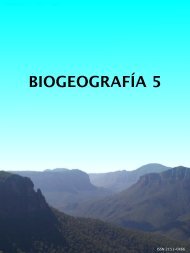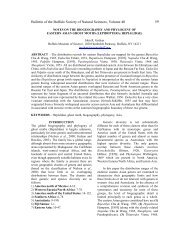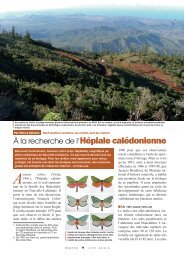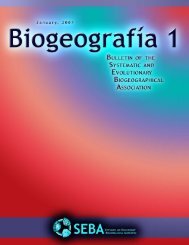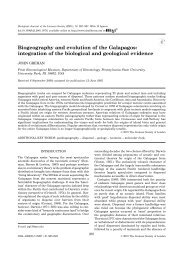You also want an ePaper? Increase the reach of your titles
YUMPU automatically turns print PDFs into web optimized ePapers that Google loves.
Saccharum 1. Nr. s.l. – 600 m.<br />
Microstegium 1. Nr. s.l. – 900 m.<br />
Ischaemum 1. No altitudinal information available (known from the type only).<br />
Limestone.<br />
Chrysopogon 1. Nr. s.l. – 900 m. ‘Probably an aboriginal introduction’ (Parham in<br />
Smith), although it grows well on coastal limestone in Niue (R.O. Gardner pers.<br />
comm., Sept. 2005). Limestone.<br />
Van Balgooy (1971) accepted 16 other grass genera as indigenous to Fiji, a discrepancy which<br />
illustrates the problems of ascertaining original distributions in this weedy and cultivated<br />
family. Six of the genera accepted by van Balgooy that are the most likely to be indigenous are<br />
the following, with evaluations by Parham (in Smith):<br />
Setaria 1. s.l., inner edges of mangrove swamps, swampy areas, rocky places, open<br />
hillsides, along roadsides, cultivated areas – ‘several hundred’ metres. Warmer parts of<br />
the north temperate Old World, now widely distributed in the tropical Old World and<br />
other areas.<br />
Oplismenus 3. Two of these ‘appear to have been very early, possibly aboriginal<br />
introductions’. s.l. – 900 m.<br />
Sacciolepis 1. s.l. – 1000 m. Common throughout Fiji, ‘which suggests it was an early<br />
introduction’.<br />
Ancistrachne 1. 240 m. ‘The distribution, if natural, is very unusual’. It is not clear<br />
whether this refers to the distribution outside Fiji (Australia, New Caledonia,<br />
Philippines), or within Fiji (Mamanucas and Makodroga, Loma-i-Viti). Neither is<br />
especially unusual.<br />
Heteropogon 1. s.l. – 250 m, ‘aboriginal or very early European introduction’.<br />
Coix 1. s.l. – 900 m, ‘presumed’ aboriginal introduction.<br />
39. Arecaceae 11/24. Additional altitude information has been taken from Fuller (1997) and<br />
Watling 2005).<br />
Pritchardia 1. s.l. – 80 m. Only on limestone islets and limestone lagoon cliffs: ‘the<br />
palms grow right down to the edge of the sea, and are subject to salt spray from large<br />
waves’ (Fuller & Jones 1999).<br />
Metroxylon 1. Coastal and some inland records (one of the specimens cited by<br />
McClatchey, 1999, is from ‘near sea-level’). No other altitudinal information is<br />
available. The Fijian species belongs to sect. Coelococcus which was revised by<br />
McClatchey (1999).<br />
Calamus 1. Nr. s.l. – 800 m.<br />
Veitchia 4. Nr. s.l. – 1200 m. Close behind mangrove (Watling 2005), exposed<br />
limestone karst (Watling 2005). Two species accepted by Moore (in Smith) were<br />
synonymised by Doyle & Fuller (1998), and one was deleted by them as ‘dubious’.<br />
Three other species accepted by Moore (in Smith) were synonymised by Zona &<br />
Fuller (1999).<br />
Balaka 6. Nr. s.l. – 1000 m. One species was deleted by Doyle & Fuller (1998) as<br />
‘dubious’, one new species was described by Fuller & Dowe (1999), and one species<br />
remains undescribed (Doyle & Fuller 1998).<br />
Neoveitchia 1. No altitudinal information is available apart from one collection (Naqali<br />
7



